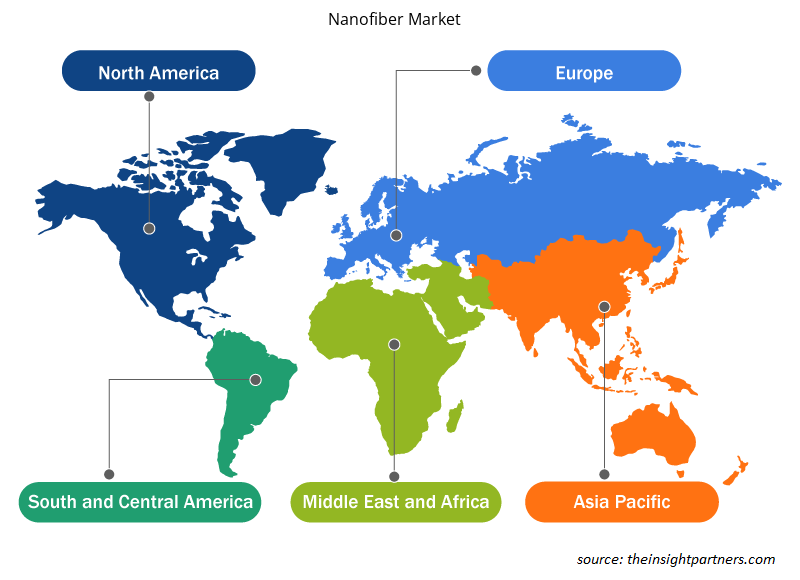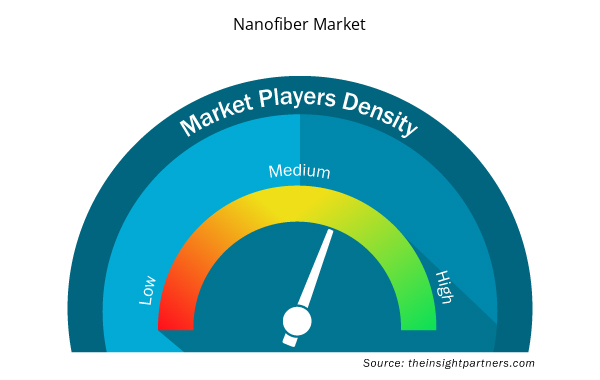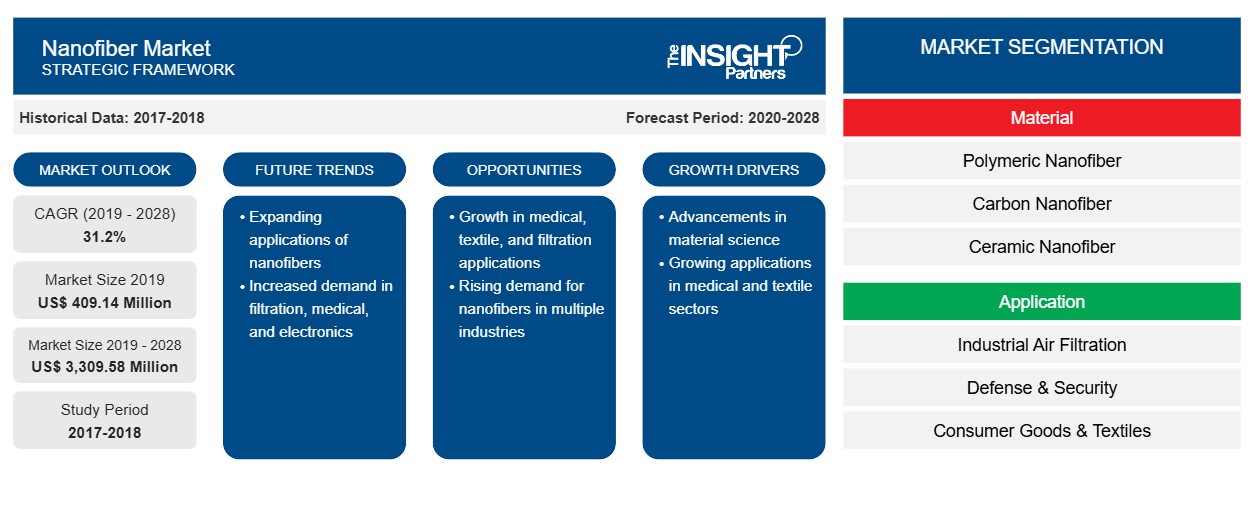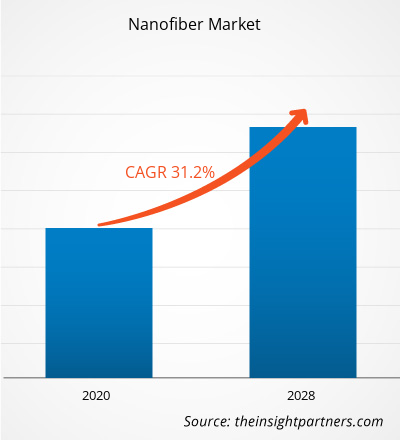2019 年纳米纤维市场价值为 4.0914 亿美元,预计到 2028 年将达到 33.0958 亿美元;预计 2020 年至 2028 年的复合年增长率为 31.2%。
纳米纤维是一种直径小于 1 µm 的纤维。这些纤维有助于提高过滤效率,同时渗透性略有下降。工业化的快速发展、纳米纤维产品的商业化程度不断提高以及工业应用的不断增加、技术创新的不断努力以及研发投资的增加是推动纳米纤维市场增长的重要因素。
2019 年,亚太地区是纳米纤维的最大市场。亚太地区是许多发展中国家的所在地,这些国家的制造业正在高速增长;该地区已成为全球制造业中心。随着中国逐渐发展成为高技能制造业中心,印度、韩国、台湾和越南等其他发展中国家也吸引了许多企业,这些企业正寻求将其中低技能制造设施迁移到劳动力成本较低的邻国。这些国家的政府也通过改善投资理念或鼓励外国直接投资 (FDI) 来欢迎此类企业。
由于各国政府实施封锁、旅行禁令和企业停工,COVID-19 已对各国的经济和行业产生不利影响。化学和材料行业是遭受严重破坏的主要行业之一,其供应链中断、技术活动取消和办公室关闭等形式都受到了严重破坏。北美、欧洲、亚太地区、南美、中东和非洲等地多家工厂的关闭限制了全球供应链,扰乱了制造活动、交付计划和产品销售。此外,多家公司已经预测到产品交付可能会延迟,未来产品销售可能会下滑。欧洲、亚洲和北美各国实施的旅行禁令阻碍了商业合作和伙伴关系机会。除了这些限制之外,由于保持社交距离措施导致专业人员数量有限和生产水平下降,也是阻碍化学和材料行业以及与其相关的各种市场活动的因素。许多国家现在正在恢复正常,而许多国家正在经历第二波疫情。此外,由于疫苗接种运动,未来几个月的情况可能会发生变化。
定制此报告以满足您的需求
您可以免费定制任何报告,包括本报告的部分内容、国家级分析、Excel 数据包,以及为初创企业和大学提供优惠和折扣
- 获取此报告的关键市场趋势。这个免费样品将包括数据分析,从市场趋势到估计和预测。
市场洞察
工业化进程加快,减少工业工厂有害排放的必要性
随着越来越多的新兴地区投资于本地制造工厂,全球制造业正在迅速扩张。根据中国物流与采购联合会 (CFLP) 的数据,2017 年 10 月全球制造业的采购经理人指数 (PMI) 为 55.1,而 2017 年 9 月为 55.9;然而,该指数在这几个月总体上处于峰值。自 2017 年初以来,PMI 指数约为 53.5,表明发达国家制造业强劲复苏,新兴经济体工业进步不断加快,全球市场大宗商品价格不断上涨。蓬勃发展的制造业预计将采用技术进步来提高工厂生产力并及时了解客户偏好的变化,从而获得竞争优势。制造业目前正处于技术复兴之中,这正在改变现代工厂的前景和流程。然而,各行业运营的扩大也加剧了环境危害,尤其是在工业化程度较高的城市。重工业化还通过有毒排放影响着这些企业附近居民的健康。
材料洞察
根据材料,纳米纤维市场细分为聚合物纳米纤维、碳纳米纤维、陶瓷纳米纤维、玻璃纳米纤维等。碳纳米纤维部分在 2020 年占据了纳米纤维市场的最大份额。碳纳米纤维是通过在极高的温度下从合成聚合物和生物聚合物中消除非碳元素而制成的。在碳纳米纤维制造的浮动催化剂法中,粉末或载体形式的各种金属被用作催化实体。箔、纱布和金属丝等是用于生产纳米纤维的其他催化剂。碳纳米纤维表现出高不连续性和兼容性以及其他物理特性,并且具有高度的石墨性。它们具有优异的机械性能以及高电导率和热导率。碳纳米纤维的应用领域包括热塑性塑料、弹性体、热固性塑料、陶瓷、弹性体和金属。此外,由于其高抗拉强度、热导率和电导率,碳纳米纤维还广泛应用于骨科、牙科和组织工程支架。
应用程序洞察
根据应用,纳米纤维市场细分为工业空气过滤、国防与安全、消费品与纺织品、电子元件、电力与能源、医疗保健与生命科学、化学与环境等。医疗保健与生命科学部门在 2020 年占据最大份额,引领市场。纳米纤维中使用的可生物降解材料最适合医疗保健行业。此外,添加剂的集成使这些纳米纤维具有多种功能。由于它们的结构和尺寸可以控制,因此它们可用于组织工程。纳米纤维在生命科学和制药行业的一些主要应用包括药物输送、伤口愈合、组织工程和屏障纺织品。
纳米纤维市场的主要参与者包括 Ahlstrom-Munksjo、旭化成株式会社、唐纳森公司、杜邦、Nanofibers Solution LLC、东丽工业公司、Espin Technologies、Elmarco SRO、Mempro Ltd. 和 Revolution Fibers Ltd。市场上的主要公司专注于并购和产品发布等战略,以扩大其地理分布和消费者基础。例如,2018 年,唐纳森推出了创新系统,使燃气轮机过滤器的选择更容易,以便操作员选择替换的空气过滤器,并开发实验室测试来量化脉冲恢复率和水密性。
报告亮点
- 全球纳米纤维市场的渐进式行业趋势,帮助参与者制定有效的长期战略
- 在发达市场和发展中市场运营的公司所采用的业务增长战略
- 2017 年至 2027 年全球纳米纤维市场定量分析
- 各行业对纳米纤维的需求估计
- PEST 分析可说明行业内买家和供应商预测市场增长的有效性
- 了解竞争激烈的市场形势和纳米纤维需求的最新发展
- 市场趋势和前景以及推动和抑制纳米纤维市场增长的因素
- 启发性战略支撑全球纳米纤维市场增长的商业利益,以促进决策过程
- 纳米纤维市场在各个市场节点的规模
- 纳米纤维市场的详细概述和细分,以及行业动态
- 各地区纳米纤维市场规模及增长机遇
纳米纤维市场区域洞察
Insight Partners 的分析师已详尽解释了预测期内影响纳米纤维市场的区域趋势和因素。本节还讨论了北美、欧洲、亚太地区、中东和非洲以及南美和中美洲的纳米纤维市场细分和地理位置。

- 获取纳米纤维市场的区域特定数据
纳米纤维市场报告范围
| 报告属性 | 细节 |
|---|---|
| 2019 年市场规模 | 4.0914亿美元 |
| 2028 年市场规模 | 33.0958亿美元 |
| 全球复合年增长率(2019 - 2028) | 31.2% |
| 史料 | 2017-2018 |
| 预测期 | 2020-2028 |
| 涵盖的领域 | 按材质
|
| 覆盖地区和国家 | 北美
|
| 市场领导者和主要公司简介 |
|
纳米纤维市场参与者密度:了解其对业务动态的影响
纳米纤维市场正在快速增长,这得益于终端用户需求的不断增长,而这些需求又源于消费者偏好的不断变化、技术进步以及对产品优势的认识不断提高等因素。随着需求的增加,企业正在扩大其产品范围,进行创新以满足消费者的需求,并利用新兴趋势,从而进一步推动市场增长。
市场参与者密度是指在特定市场或行业内运营的企业或公司的分布情况。它表明在给定市场空间中,相对于其规模或总市场价值,有多少竞争对手(市场参与者)存在。
在纳米纤维市场运营的主要公司有:
- 阿尔斯特罗姆-蒙克舍
- 旭化成公司
- 唐纳森公司
- 杜邦
- 纳米纤维解决方案有限责任公司
免责声明:上面列出的公司没有按照任何特定顺序排列。

- 获取纳米纤维市场顶级关键参与者的概述
纳米纤维市场(按材料分类)
- 聚合物纳米纤维
- 碳纳米纤维
- 陶瓷纳米纤维
- 玻璃纳米纤维
- 其他的
纳米纤维市场 – 按应用分类
- 工业空气过滤
- 消费品和纺织品
- 电子元件
- 国防和安全
- 电力与能源
- 医疗保健与生命科学
- 化学品与环境
- 其他的
公司简介
- Ahlstrom-Munksjo,
- 旭化成公司
- 唐纳森公司
- 杜邦
- 纳米纤维解决方案有限责任公司
- 东丽株式会社
- Espin 技术
- 埃尔马科
- Mempro 有限公司
- 革命纤维有限公司
- 历史分析(2 年)、基准年、预测(7 年)及复合年增长率
- PEST 和 SWOT 分析
- 市场规模价值/数量 - 全球、区域、国家
- 行业和竞争格局
- Excel 数据集



Report Coverage
Revenue forecast, Company Analysis, Industry landscape, Growth factors, and Trends

Segment Covered
This text is related
to segments covered.

Regional Scope
North America, Europe, Asia Pacific, Middle East & Africa, South & Central America

Country Scope
This text is related
to country scope.
常见问题
Polymeric nanofibers are generated from naturally or artificially synthesized polymers. Natural polymers include collagen, silk fibroin, cellulose, gelatin, chitosan and polysaccharides. While synthetic polymers include nylon, polyacrylonitrile, polystyrene, polycarbonate, Polyethylene terephthalate (PET), and water-soluble polymers. These fibers possess high specific area, excellent porosity and better flexibility in surface functionalities. They find enormous applications in various domains such as filtration, material reinforcements, energy storage, sensor devices and others. The growing demand from energy, water, chemicals, pharmaceutical, biotechnology, and food & beverage industries are expected to drive the market for polymer nanofibers across the globe. Apart from this, they are utilized in bone tissue engineering applications in the medical sector which further fueling the demand for polymer nanofiber globally.
The major players operating in the global nanofiber market are Ahlstrom-Munksjo, Asahi Kasei Corporation, Donaldson Company, Inc., DuPont, Nanofibers Solution LLC, Inc., Toray Industries, Inc., Espin Technologies, Elmarco S.R.O., Mempro Ltd., and Revolution Fibers Ltd.
In 2019, Asia Pacific contributed to the largest share in the global nanofiber market. The improving infrastructure, rising domestic consumption and lower costs are some of the factors attracting manufacturing companies in these countries. The development of manufacturing hub creates the demand for nanofibers to be used for a diverse range of purposes. Several governments have taken initiatives such as Made in China 2025, and Make in India, among others to propel the growth of manufacturing sector which further supports the growth of nanofibers market.
Trends and growth analysis reports related to Chemicals and Materials : READ MORE..
The List of Companies - Global Nanofiber Market
- Ahlstrom-Munksjo
- Asahi Kasei Corporation
- Donaldson Company, Inc
- DuPont
- Nanofibers Solution LLC, Inc.
- Toray Industries, Inc
- Espin Technologies
- Elmarco S.R.O.
- Mempro Ltd.
- Revolution Fibers Ltd.
The Insight Partners performs research in 4 major stages: Data Collection & Secondary Research, Primary Research, Data Analysis and Data Triangulation & Final Review.
- Data Collection and Secondary Research:
As a market research and consulting firm operating from a decade, we have published and advised several client across the globe. First step for any study will start with an assessment of currently available data and insights from existing reports. Further, historical and current market information is collected from Investor Presentations, Annual Reports, SEC Filings, etc., and other information related to company’s performance and market positioning are gathered from Paid Databases (Factiva, Hoovers, and Reuters) and various other publications available in public domain.
Several associations trade associates, technical forums, institutes, societies and organization are accessed to gain technical as well as market related insights through their publications such as research papers, blogs and press releases related to the studies are referred to get cues about the market. Further, white papers, journals, magazines, and other news articles published in last 3 years are scrutinized and analyzed to understand the current market trends.
- Primary Research:
The primarily interview analysis comprise of data obtained from industry participants interview and answers to survey questions gathered by in-house primary team.
For primary research, interviews are conducted with industry experts/CEOs/Marketing Managers/VPs/Subject Matter Experts from both demand and supply side to get a 360-degree view of the market. The primary team conducts several interviews based on the complexity of the markets to understand the various market trends and dynamics which makes research more credible and precise.
A typical research interview fulfils the following functions:
- Provides first-hand information on the market size, market trends, growth trends, competitive landscape, and outlook
- Validates and strengthens in-house secondary research findings
- Develops the analysis team’s expertise and market understanding
Primary research involves email interactions and telephone interviews for each market, category, segment, and sub-segment across geographies. The participants who typically take part in such a process include, but are not limited to:
- Industry participants: VPs, business development managers, market intelligence managers and national sales managers
- Outside experts: Valuation experts, research analysts and key opinion leaders specializing in the electronics and semiconductor industry.
Below is the breakup of our primary respondents by company, designation, and region:

Once we receive the confirmation from primary research sources or primary respondents, we finalize the base year market estimation and forecast the data as per the macroeconomic and microeconomic factors assessed during data collection.
- Data Analysis:
Once data is validated through both secondary as well as primary respondents, we finalize the market estimations by hypothesis formulation and factor analysis at regional and country level.
- Macro-Economic Factor Analysis:
We analyse macroeconomic indicators such the gross domestic product (GDP), increase in the demand for goods and services across industries, technological advancement, regional economic growth, governmental policies, the influence of COVID-19, PEST analysis, and other aspects. This analysis aids in setting benchmarks for various nations/regions and approximating market splits. Additionally, the general trend of the aforementioned components aid in determining the market's development possibilities.
- Country Level Data:
Various factors that are especially aligned to the country are taken into account to determine the market size for a certain area and country, including the presence of vendors, such as headquarters and offices, the country's GDP, demand patterns, and industry growth. To comprehend the market dynamics for the nation, a number of growth variables, inhibitors, application areas, and current market trends are researched. The aforementioned elements aid in determining the country's overall market's growth potential.
- Company Profile:
The “Table of Contents” is formulated by listing and analyzing more than 25 - 30 companies operating in the market ecosystem across geographies. However, we profile only 10 companies as a standard practice in our syndicate reports. These 10 companies comprise leading, emerging, and regional players. Nonetheless, our analysis is not restricted to the 10 listed companies, we also analyze other companies present in the market to develop a holistic view and understand the prevailing trends. The “Company Profiles” section in the report covers key facts, business description, products & services, financial information, SWOT analysis, and key developments. The financial information presented is extracted from the annual reports and official documents of the publicly listed companies. Upon collecting the information for the sections of respective companies, we verify them via various primary sources and then compile the data in respective company profiles. The company level information helps us in deriving the base number as well as in forecasting the market size.
- Developing Base Number:
Aggregation of sales statistics (2020-2022) and macro-economic factor, and other secondary and primary research insights are utilized to arrive at base number and related market shares for 2022. The data gaps are identified in this step and relevant market data is analyzed, collected from paid primary interviews or databases. On finalizing the base year market size, forecasts are developed on the basis of macro-economic, industry and market growth factors and company level analysis.
- Data Triangulation and Final Review:
The market findings and base year market size calculations are validated from supply as well as demand side. Demand side validations are based on macro-economic factor analysis and benchmarks for respective regions and countries. In case of supply side validations, revenues of major companies are estimated (in case not available) based on industry benchmark, approximate number of employees, product portfolio, and primary interviews revenues are gathered. Further revenue from target product/service segment is assessed to avoid overshooting of market statistics. In case of heavy deviations between supply and demand side values, all thes steps are repeated to achieve synchronization.
We follow an iterative model, wherein we share our research findings with Subject Matter Experts (SME’s) and Key Opinion Leaders (KOLs) until consensus view of the market is not formulated – this model negates any drastic deviation in the opinions of experts. Only validated and universally acceptable research findings are quoted in our reports.
We have important check points that we use to validate our research findings – which we call – data triangulation, where we validate the information, we generate from secondary sources with primary interviews and then we re-validate with our internal data bases and Subject matter experts. This comprehensive model enables us to deliver high quality, reliable data in shortest possible time.


 获取此报告的免费样本
获取此报告的免费样本